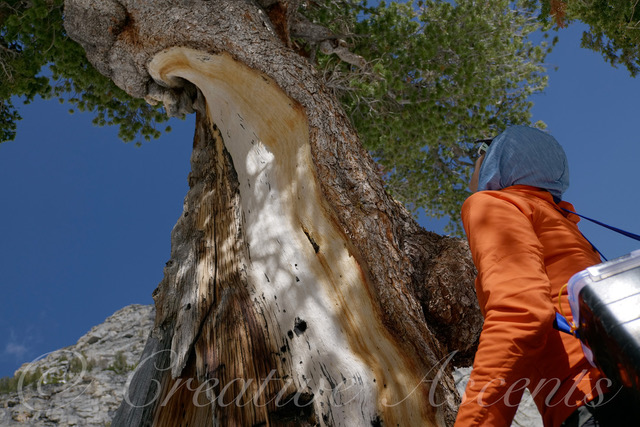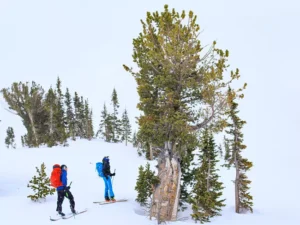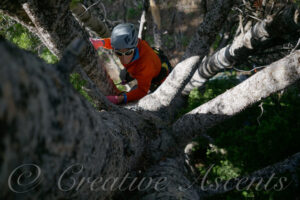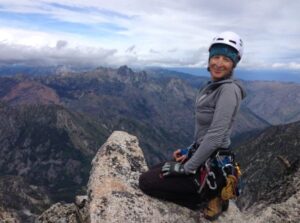
Q&A with Nancy Bockino: Whitebark Warrior
Meet Nancy Bockino, a field ecologist who has spent the past three decades dedicated to conservation efforts within the Greater Yellowstone Ecosystem. As a child of a science teacher and a passionate naturalist, Nancy spent her childhood exploring the mountains of Idaho and Montana. Now, with 24 years of experience, Nancy has become a strong advocate for the preservation of whitebark pine and the subalpine ecosystem it sustains. Her journey includes 18 years as a seasonal National Park Service employee at Grand Teton National Park, where she established the whitebark pine conservation program and helped produce For the Love of Whitebark Pine films. Currently, Nancy collaborates with key partners such as the Northern Rockies Conservation Cooperative, Caribou-Targhee National Forest, Grand Teton National Park, and American Forests, furthering her commitment to conserving whitebark pine.
What sparked your interest in whitebark pine conservation?
My love for whitebark pine began as a child when I first met them in the subalpine ecosystems in Idaho and grows stronger each time I visit them. These strong, wise, resilient characters are my dear friends and teachers. My connection to whitebark pine is a legacy – a labor of love that has been built through passion and commitment. This conservation work, in addition to mountain guiding, has defined my life. It is my path and an honor.
What specific projects or initiatives are you currently working on related to whitebark pine conservation?

Whitebark Warriors assess a whitebark pine in winter. Image Credit: Colin Wann.
My small and dedicated team of Whitebark Warriors walks thousands of miles in remote, rugged places each season doing conservation work. Our work relies upon critical long-term collaboration that I have established and continue to uphold among land managers and researchers in the Greater Yellowstone Ecosystem (GYE) and across the whitebark pine distribution. We work to protect the remaining whitebark pine that bear seeds by placing pheromone patches to deter mountain pine beetles. We collect pollen, cones, and other plant materials to support the Intermountain Region Genetic Restoration Program in their work to produce blister rust resistant seedlings. We replant seeds and seedlings, bringing them full circle from the treetops to the nursery and back again to their mountain home. We collect data to monitor, document, and research whitebark pine’s mortality, damage, regeneration, and interactions with other vegetation. We assess the landscape-level condition of whitebark pine stands and write GYE-wide management strategies, updating them with new data and research findings. We participate in conferences and produce videos, photos, and written pieces to invite others to fall in love with and protect whitebark pine. We support whitebark pine conservation far and wide from the Sierras in California to the Beartooths in Montana.
What message would you like to convey to the public about the importance of protecting whitebark pine?
Whitebark pine are the rooftops of the Rocky Mountains. They shelter all who live beneath them, promoting biodiversity and resilience by creating an environment where plants and animals can live. They also shade snow so that our rivers are full year-round and provide us with joy, adventure, and reverence for our sacred, wild places. These critical and giving trees are in desperate need of our help. Climate change has resulted in unprecedented mountain pine beetle outbreaks that have killed over 50% of mature whitebark pine across their entire range, with some areas experiencing losses of 80-90%. White pine blister rust, a disease caused by a non-native fungus, has now spread, killing cone-bearing branches and ultimately whitebark pine. Conserving whitebark pine is crucial to the resilience and health of the ecosystems of the Rocky Mountains, water conservation in the West, and the stability of our wild places.

Nancy climbing up a whitebark pine. Image Credit: Colin Wann.
Which management actions should be prioritized for whitebark pine conservation?
Whitebark pine regeneration and growth is exceedingly slow. It takes hundreds of years for a whitebark to produce substantial seeds, and seedling establishment and survival rates are low in these harsh mountain environments. Climate change creates additional recruitment and regeneration challenges. With many ecological stressors affecting whitebark pine, there is real potential for losing this keystone species. Every live remaining whitebark is a critical resource that must be protected. This must be prioritized. The management actions we take in the next several years will define subalpine forests and the health of our watersheds for the next 500 years. Protecting as many 500–1200-year-old whitebark pines as we can is paramount to conservation.
What challenges have you encountered in your conservation efforts? What are the most rewarding aspects of your work?

Nancy on the summit of Dragon Tail Peak in the Cascade Mountains. Image Credit: Jeff Witt.
The hardest part of the past 24 years is inherent – loving something that you can’t always save. Saying goodbye to trees that I have known my entire adult life is the hardest part. It can be challenging to not feel like I should have done more to keep that ancient, irreplaceable being alive.
The connections to whitebark pine and the subalpine are the most rewarding parts of my work. Being with whitebark pine in their home is what keeps my spirit alive as well as my connections to the people who love whitebark pine. The time I spend in the subalpine with my crew are the best days of my life. I am thankful for the land managers who work so hard to support the conservation of this incredible species and the local community that helps me do my work.
What advice would you give to aspiring conservationists who are passionate about protecting whitebark pine?
Find something you love and fight for it. If you go to work every day with no other reason than your love for trees and what they give to those who rely on them, you will be the change you wish to see in the world.

